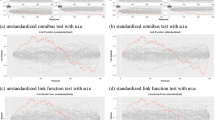Abstract
We discuss the use of a continuous-time jump Markov process as the driving process in stochastic differential systems. Results are given on the estimation of the infinitesimal generator of the jump Markov process, when considering sample paths on random time intervals. These results are then applied within the framework of stochastic dynamical systems modeling and estimation. Numerical examples are given to illustrate both consistency and asymptotic normality of the estimator of the infinitesimal generator of the driving process. We apply these results to fatigue crack growth modeling as an example of a complex dynamical system, with applications to reliability analysis.
Similar content being viewed by others
References
A. Albert, “Estimating the infinitesimal generator of a continuous time, finite state Markov process,” Annals of Mathematical Statistics vol. 38 pp. 727–753, 1962.
P. Billingsley, Statistical Inference for Markov Processes, University of Chicago Press: Chicago, 1961.
J. Chiquet, N. Limnios, and M. Eid, “Modeling and estimating the reliability of stochastic dynamical systems with markovian switching.” In ESREL 2006 - Safety and Reliability for managing Risks, 2006.
R. Dautray (ed.), Méthodes probabilistes pour les équations de la physique, Synthèse. Eyrolles: Paris, France, 1989.
M. H. A. Davis, Markov Models and Optimization, Monographs On statistics and Applied Probability 49, Chapman & Hall, UK, 1993.
S. Goldstein, “On diffusion by discontinuous movements, and on the telegraph equation,” Quarterly Journal of Mechanics and Applied Mathematics vol. 4 pp. 129–156, 1951.
W. Härdle, Applied Nonparametric Regression, Econometric Society Monographs, Cambridge University Press, Cambridge, UK, 1990.
A. Jankunas and R. Z. Khasminskii, “Estimation of parameters of linear homogeneous stochastic differential equation,” Stochastic Processes and their Applications vol. 72 pp. 205–219, 1997.
V. S. Korolyuk and N. Limnios, Stochastic Systems in Merging Phase Space, World Scientific: Singapore, 2005.
Y. A. Kutoyants, Statistical Inference for Ergodic Diffusion Processes, Springer: Berlin Heidelberg New York, 2004.
B. Lapeyre and E. Pardoux, Méthodes de Monte-Carlo pour les équations de transport et de diffusion, Springer: Berlin Heidelberg New York, 1998.
Y. K. Lin and J. N. Yang, “A stochastic theory of fatigue crack propagation,” AIAA Journal vol. 23 pp. 117–124, 1985.
B. Øksendal, Stochastic Differential Equations, 6th edn., Springer: Berlin Heidelberg New York, 2003.
A. Sadek and N. Limnios, “Nonparametric estimation of reliability and survival function for continuous time finite Markov process,” Journal of Statistical Planning and Inference vol. 133 pp. 1–21, 2005.
K. Sobczyk, Stochastic Differential Equations with Applications to Physics and Engineering, Kluwer: Dordrecht, The Netherlands, 1991.
K. Sobczyk (ed.), Stochastic Approach to Fatigue, Springer: Berlin Heidelberg New York, 1993.
B. F. Spencer, J. Tang, and M. E. Artley, “A stochastic approach to modeling fatigue crack growth,” AIAA Journal vol. 114 pp. 1628–1635, 1989.
H. Tanaka, “Importance sampling simulation for a stochastic fatigue crack growth model,” In R. E. Melchers and M. G. Stewart (eds.), Proceeding of ICASP8 vol. 2, pp. 907–914, 1999.
A. Tsurui and H. Ishikawa, “Application of the Fokker-Plank equation to a stochastic fatigue crack growth model,” Structural Safety vol. 4 pp. 15–29, 1986.
D. A. Virkler, B. M. Hillberry, and P. K. Goel, “The statistical nature of fatigue crack propagation,” Journal of Engineering Material Technology ASME vol. 101 pp. 148–153, 1979.
J. N. Yang and S. D. Manning, “A simple second order approximation for stochastic crack growth analysis,” Engineering Fracture Mechanics vol. 53 pp. 677–686, 1996.
Author information
Authors and Affiliations
Corresponding author
Rights and permissions
About this article
Cite this article
Chiquet, J., Limnios, N. Estimating Stochastic Dynamical Systems Driven by a Continuous-Time Jump Markov Process. Methodol Comput Appl Probab 8, 431–447 (2006). https://doi.org/10.1007/s11009-006-0423-z
Received:
Revised:
Accepted:
Published:
Issue Date:
DOI: https://doi.org/10.1007/s11009-006-0423-z




